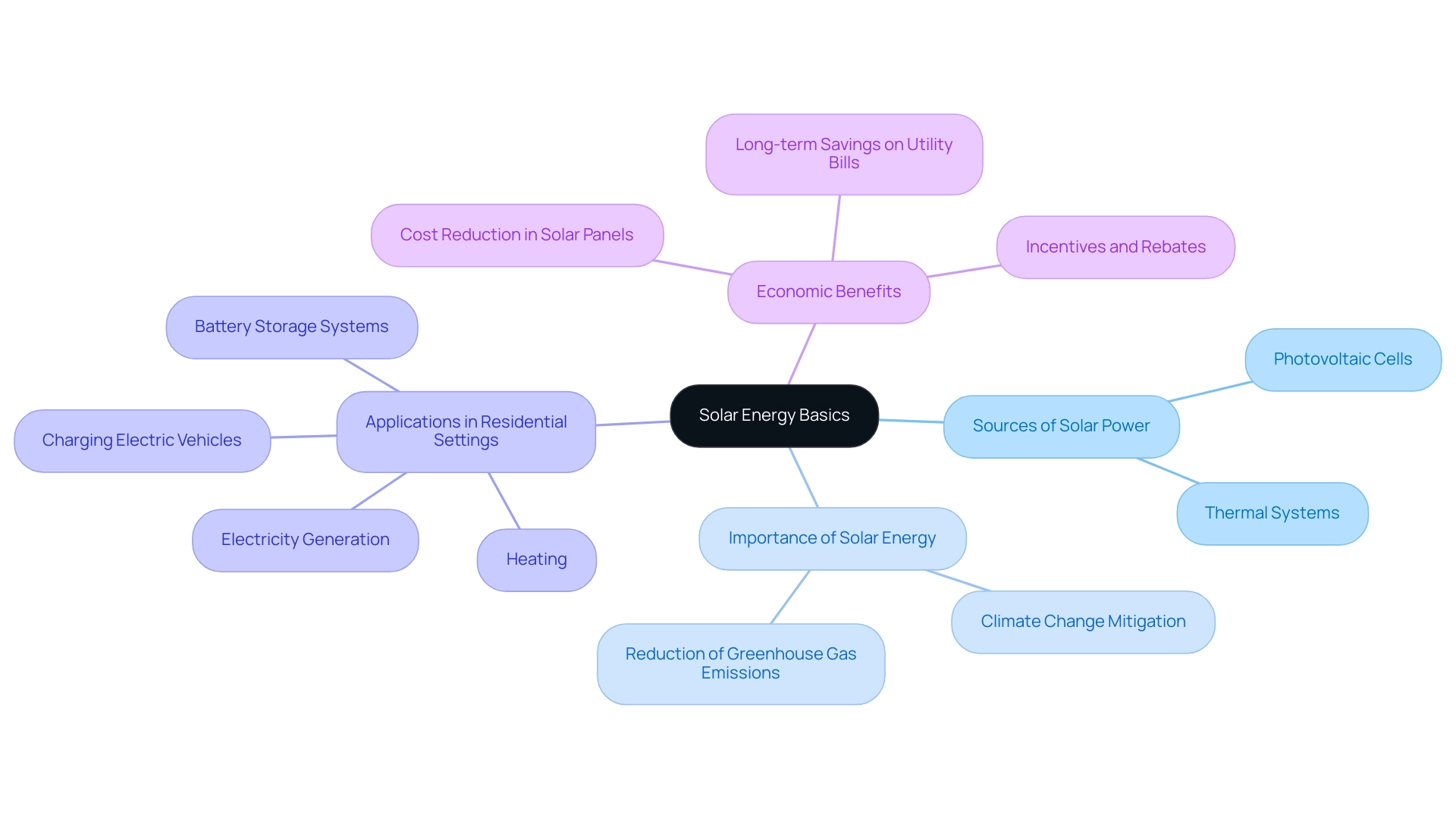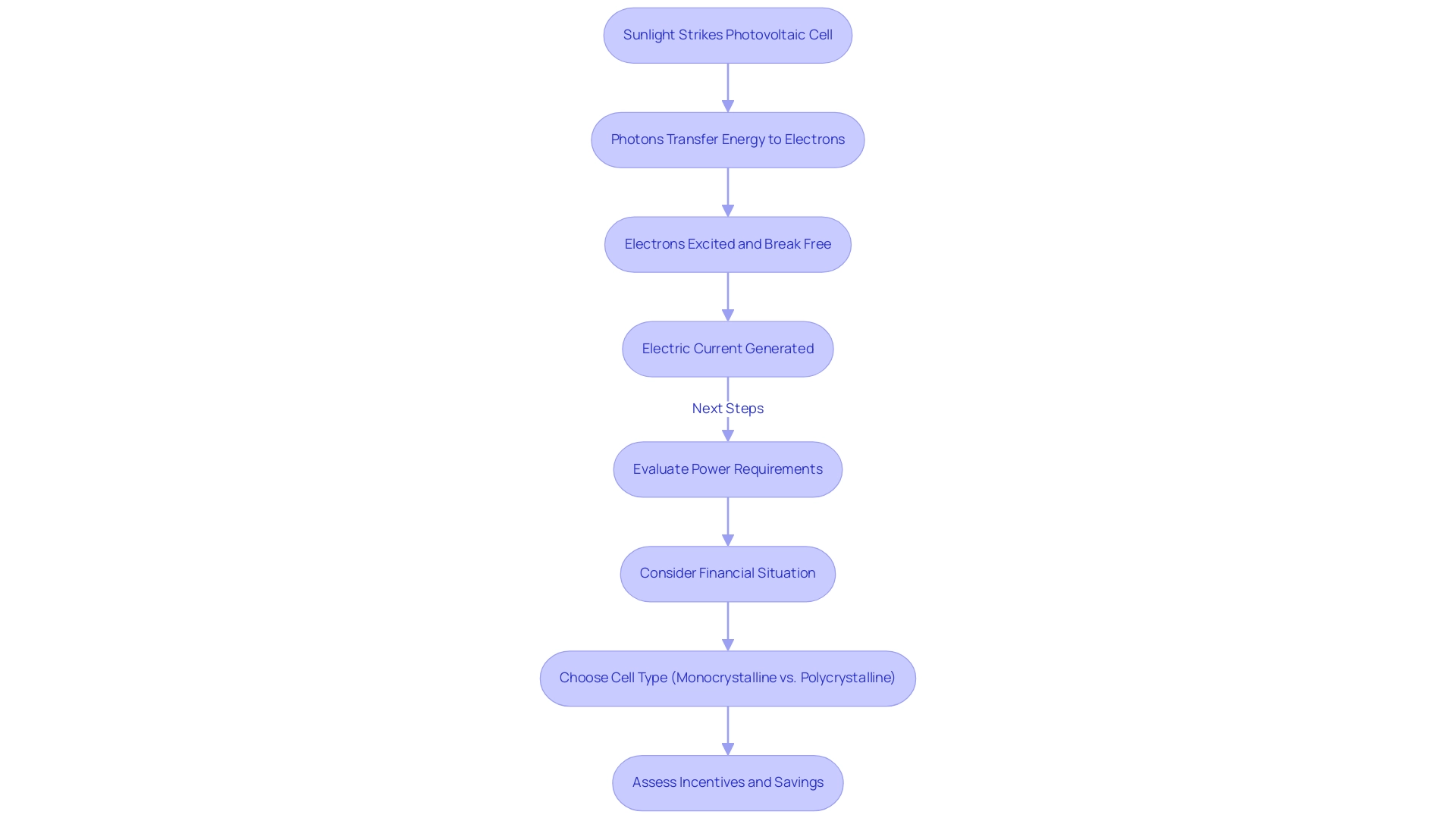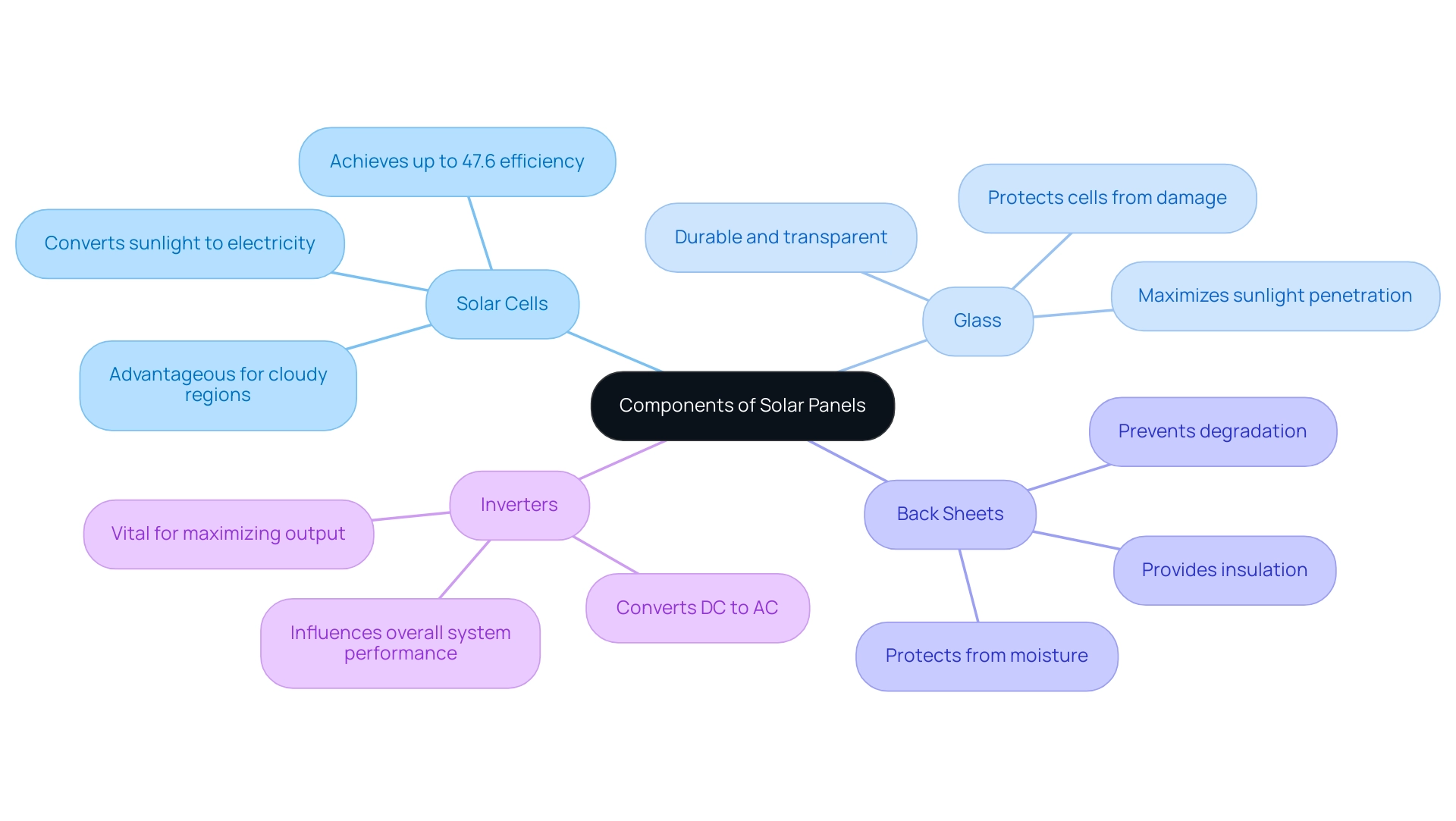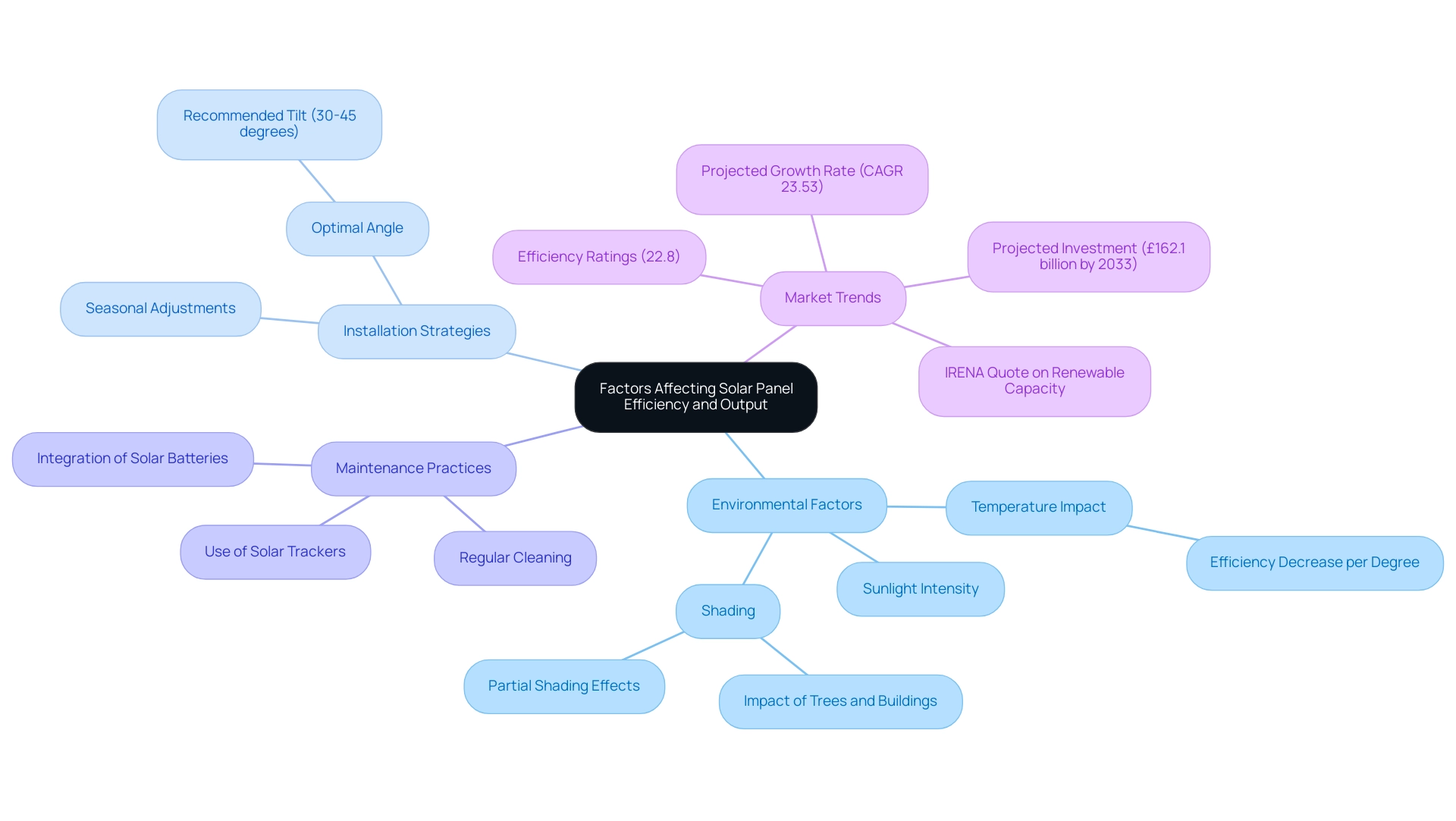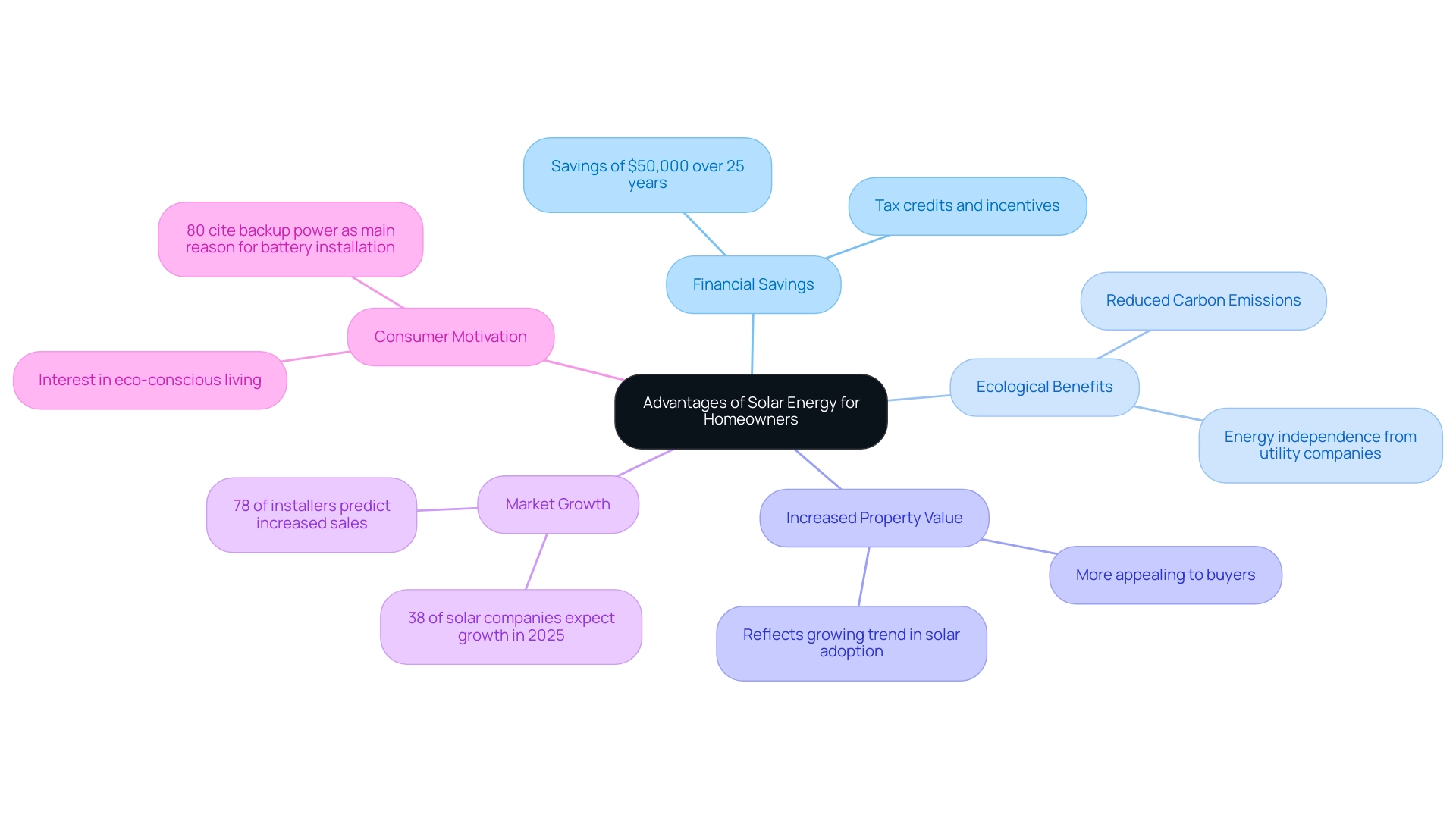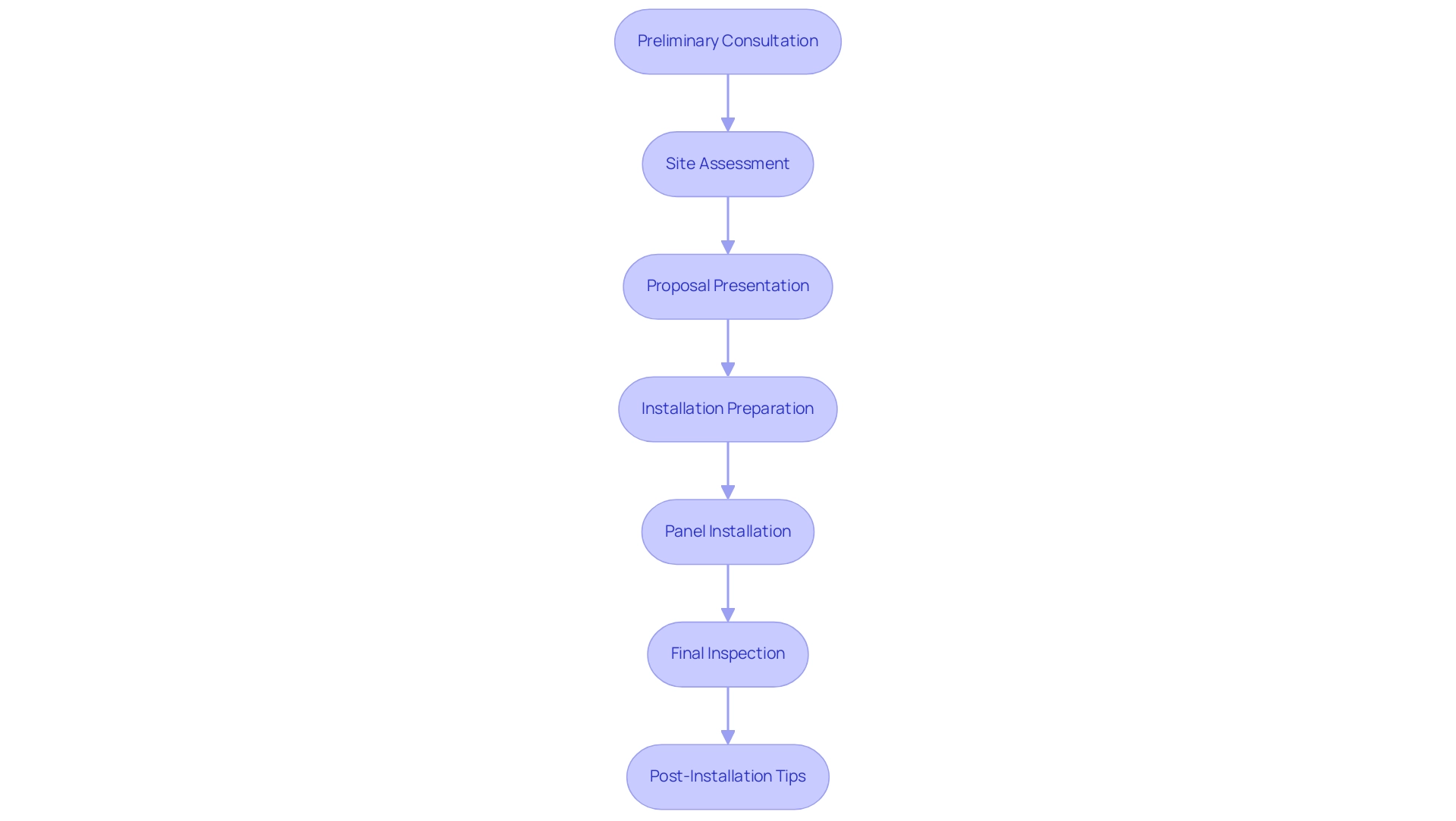Overview
We understand that many homeowners are concerned about rising energy bills and the impact they have on your budget. Solar panels offer a promising solution by producing electricity through the photovoltaic effect, where sunlight excites electrons in semiconductor materials, typically silicon, generating an electric current. With advancements in photovoltaic technology, efficiency has improved significantly. This means you can not only reduce your energy costs but also take a step towards energy independence.
Imagine being able to lower your reliance on fossil fuels and contribute to a cleaner environment. By choosing solar energy, you’re making a choice that benefits not just your household but the planet as well, helping to decrease carbon emissions. It’s common to feel overwhelmed by the options available, but you’re not alone in this journey. Together, we can explore how solar energy can transform your home into a more sustainable haven.
Let’s work towards a brighter future. If you’re interested in learning more about how solar panels can benefit you and your family, don’t hesitate to reach out. We’re here to support you every step of the way.
Introduction
As we collectively turn our attention toward sustainable energy solutions, solar energy emerges as a beacon of hope for homeowners who are concerned about rising energy bills and their carbon footprint. By harnessing the power of the sun, not only can you achieve significant financial savings, but you also contribute to a cleaner, more sustainable future for all of us.
With recent advancements in technology making solar systems more efficient and accessible, understanding the intricacies of solar energy—from the photovoltaic effect to installation processes—has never been more essential.
This article explores the core aspects of solar energy, highlighting its benefits, challenges, and the transformative impact it can have on individual households and our environment.
If you’re contemplating a solar panel installation or simply eager to learn more about this renewable resource, we invite you to discover valuable insights that will empower you to make informed decisions for a greener tomorrow.
Together, we can work towards a sustainable future.
Understanding Solar Energy: The Basics
Solar power is derived from sunlight, a clean and abundant resource that can be harnessed for various applications, including electricity generation, heating, and powering household appliances. We understand that many homeowners are concerned about rising energy bills. The main sources of sunlight power, such as photovoltaic cells, are crucial for explaining how solar panels produce electricity, while thermal systems utilize sunlight to produce heat.
The importance of sunlight power within the renewable resources landscape cannot be overstated. As the world confronts climate change and the exhaustion of fossil fuels, sunlight power arises as a crucial alternative. In 2025, California remains at the forefront in harnessing renewable power, with over 30% of the state’s electricity produced from sunlight sources. This transition not only promotes energy autonomy but also aligns with California’s ambitious targets to decrease greenhouse gas emissions by 40% compared to 1990 levels by 2030.
Furthermore, since 2010, the Department of Energy has invested over $21 million in around 40 California tribal renewable power projects, showcasing the state’s dedication to advancing renewable initiatives. Together, we can make a difference in reducing carbon footprints and decreasing costs for homeowners. By shifting to renewable power, households can significantly decrease their dependence on conventional sources, which are often associated with high carbon emissions. For example, a standard residential photovoltaic system can offset roughly 100 tons of carbon dioxide throughout its lifespan, comparable to planting more than 2,500 trees. This decrease in emissions is crucial for addressing climate change and fostering a healthier environment.
Practical uses of sunlight harnessing in residential settings demonstrate how solar panels produce electricity becoming more prevalent. Homeowners are setting up photovoltaic systems not only to power their residences but also to understand how solar panels produce electricity for charging electric vehicles and storing electricity for later use through battery systems. A notable example is the Viejas Tribe of Kumeyaay Indians, which received $31 million for a long-duration power storage system in 2022. This initiative not only improves grid reliability during emergencies but also demonstrates the potential of photovoltaic systems to offer sustainable solutions in various communities.
As the cost of residential photovoltaic panels has dropped by 40% over the past decade, according to the Solar Energy Industries Association, more property owners are recognizing the financial advantages of such systems. With incentives and rebates offered, investing in renewable technology has become an appealing choice for those aiming to lower their utility costs while aiding in the creation of a cleaner planet. The ongoing advancements in renewable technology and increasing awareness of its benefits position this energy source as a cornerstone of sustainable living for residents in California and beyond.
Powercore Electric prides itself on being locally owned and community-centered, ensuring personalized service and support for individuals looking to make the transition to clean energy. By providing expert insights into both active and passive heating systems, Powercore Electric assists homeowners in selecting the optimal solutions tailored to their specific needs, maximizing both economic and environmental advantages. Together, we can work towards a brighter, more sustainable future.
The Photovoltaic Effect: How Solar Panels Generate Power
The photovoltaic effect is a fundamental process that shows how solar panels can produce electricity by converting sunlight into energy. When photons from sunlight strike a photovoltaic cell, they transfer their energy to electrons within the cell’s semiconductor material, usually silicon. This energy excites the electrons, allowing them to break free from their atomic bonds, which is how solar panels generate an electric current.
This phenomenon is crucial for effectively harnessing sunlight energy.
As we look to the future, advancements in photovoltaic technology in 2025 have led to significant improvements in the efficiency of energy cells. Recent research indicates that high-efficiency panels can achieve conversion rates exceeding 22%, maximizing the amount of sunlight transformed into usable electricity. This efficiency is essential for homeowners aiming to enhance their savings and reduce dependence on conventional power sources.
Moreover, heating systems can save homeowners between $400 to $600 annually on utility expenses, further enhancing the financial benefits of adopting renewable energy.
There are primarily two categories of photovoltaic cells used in residential systems:
- Monocrystalline cells, known for their high efficiency and sleek appearance, are made from a single crystal structure, allowing for better performance in low-light conditions.
- Polycrystalline cells, composed of multiple crystal structures, are generally less expensive but offer slightly lower efficiency rates.
When choosing the kind of photovoltaic system that best meets their needs, property owners should evaluate their power requirements and financial situations.
A compelling case study reveals that while homeowners primarily install photovoltaic panels to reduce utility expenses, a substantial 80% of those who opt for battery storage do so mainly for backup power capabilities. This trend underscores the increasing importance of reliable power sources, especially in areas prone to outages. Furthermore, incorporating a battery for renewable power can enhance savings by as much as 90%, offering significant financial advantages and improving self-sufficiency.
Additionally, state incentives, including tax credits and storage rebates, play a vital role in boosting the demand for renewable solutions, making them more attainable for homeowners. Recent news indicates that supply chain disruptions have eased, leading to declining module prices, which is favorable for those considering the installation of energy systems. As IRENA states, “To stay on a pathway limiting global warming to 1.5°C, annual renewable power capacity additions must grow three times the current level by 2030.”
By understanding how solar panels produce electricity through the photovoltaic effect and the varieties of cells available, homeowners can make informed choices that align with their energy goals and contribute to a sustainable future. Together, we can work towards a brighter, more independent energy landscape.
Components of Solar Panels: What Makes Them Work?
Are you feeling overwhelmed by rising energy bills? You’re not alone. Many homeowners share your concerns, and that’s where solar energy comes in as a beacon of hope. The main elements of photovoltaic modules consist of photovoltaic cells, glass, back sheets, and inverters, each playing a crucial role in the energy generation process:
- Solar Cells: These are the heart of the solar panel, responsible for converting sunlight into electricity through the photovoltaic effect. Recent advancements have led to photovoltaic cells achieving efficiencies as high as 47.6%, showcasing the potential for increased energy output, especially advantageous for residents in cloudy regions.
- Glass: The protective layer that covers the photovoltaic cells, glass is designed to be durable and transparent, allowing maximum sunlight to penetrate while shielding the cells from environmental damage. High-quality glass can significantly improve the durability and efficiency of photovoltaic systems, making it an essential factor for environmentally aware homeowners.
- Back Sheets: These offer insulation and protection for the cells from moisture and physical damage. The quality of back sheets is essential for preserving the integrity of the panel over time, as they help prevent degradation, ensuring that your investment lasts.
- Inverters: These components convert the direct current (DC) produced by photovoltaic cells into alternating current (AC), which is utilized in homes. The efficiency of inverters can significantly influence the overall performance of a renewable power system, making their selection vital for maximizing output.
Understanding the significance of quality materials in photovoltaic systems cannot be overstated. Premium components guarantee not only the effectiveness of power transformation but also the longevity and durability of the modules. For example, utilizing advanced photovoltaic cells can result in a substantial boost in power production, with research showing that improved materials can elevate efficiency by as much as 20%.
Case studies have shown that installations utilizing premium materials consistently outperform those with lower-quality components. For instance, a recent case study showed that residences utilizing high-efficiency photovoltaic panels experienced a 30% rise in power generation compared to those with standard panels. As of Q3 2024, photovoltaic technology has emerged as the primary option for new power capacity in the U.S., with forecasts suggesting a consistent installation rate of 40-45 GW each year for the next five years.
This growth is partly attributed to the adoption of high-quality materials, which have been shown to reduce maintenance costs and improve overall system reliability.
Significantly, California produced around 29% of its electricity from photovoltaic sources, highlighting the importance of renewable options for residents in the area, especially those looking into local solar firms in Stockton. However, it’s common to feel cautious about potential investments, especially given the volatile pricing related to solar energy over the last three years due to inflation and supply chain challenges, which could impact your decisions.
In conclusion, understanding how solar panels produce electricity and the primary elements of photovoltaic systems, as well as the vital role that high-quality materials play in their effectiveness and durability, is crucial for residents contemplating renewable power options. By investing in premium photovoltaic modules, you can guarantee a more dependable and efficient power generation system. As Anna Brui, a passionate advocate for renewable energy, emphasizes, “Transitioning to sustainable energy is not just a choice; it’s a responsibility we owe to our planet.”
Together, we can navigate this journey toward energy independence. For further details on how to begin your energy system installation, reach out to Powercore Electric today.
Factors Affecting Solar Panel Efficiency and Output
-
We understand that environmental factors can be a significant concern when it comes to the efficiency of photovoltaic systems. Elements such as sunlight intensity, temperature, and shading can greatly impact energy production. For instance, photovoltaic cells thrive in direct sunlight; however, their efficiency can decrease by about 0.5% for each degree Celsius rise above 25°C. This means that in warmer regions, it’s crucial to thoughtfully consider the placement of the modules to optimize output.
-
It’s common to feel frustrated by shading from trees, buildings, or other obstructions, as these can hinder the performance of your solar installations. Even partial shading can lead to a substantial reduction in power production, affecting the entire string of modules linked in series. We encourage property owners to evaluate their land for potential shading issues throughout the day and year to ensure ideal sunlight access.
-
The installation angle and direction of photovoltaic systems are vital for maximizing power collection. Ideally, panels should be installed at an angle that aligns with the latitude of your location, allowing them to capture the most sunlight year-round. For example, a tilt angle of approximately 30 to 45 degrees is often recommended for many regions, but adjustments may be necessary based on seasonal variations in sunlight.
-
As homeowners, you can enhance your solar panel efficiency by implementing a few simple strategies:
- Regularly cleaning your panels to remove dust and debris, which can block sunlight. Top solar panel cleaning services can assist in maintaining optimal performance.
- Adjusting the installation angle seasonally to capture the sun’s changing position.
- Utilizing solar trackers that automatically adjust the panel orientation to follow the sun’s path, thereby increasing energy capture.
- Considering the integration of solar batteries for efficient energy storage, which can further optimize the use of generated solar power.
-
By understanding these environmental factors and making informed adjustments, you can significantly improve the performance of your solar energy systems, leading to greater energy savings and sustainability. It’s encouraging to note that the most efficient commercially available photovoltaic modules have an efficiency rating of around 22.8%, showcasing remarkable advancements in technology. Moreover, as IRENA indicates, to stay on track in limiting global warming to 1.5°C, we must triple the current rate of yearly renewable energy capacity increases by 2030. This highlights the importance of enhancing the efficiency of photovoltaic systems. Furthermore, the anticipated expansion of the UK photovoltaic market at a CAGR of 23.53% reflects the growing demand for renewable solutions, while the projected investment in PV reaching £162.1 billion by 2033 underscores the commitment to technological advancements. Together, we can work towards a sustainable future.
Advantages of Solar Energy for Homeowners
As a homeowner, you may be feeling the weight of rising electricity expenses. Imagine being able to significantly lower those costs—estimates suggest that you could save around $50,000 over 25 years simply by installing photovoltaic panels. This financial advantage is further enriched by potential tax credits and incentives available for renewable power systems, including government programs that support the adoption of these technologies. In the case study titled “How Homeowners Benefited from Household Solar Systems Under the 200% Rule,” you’ll find concrete examples of these benefits. While savings can vary by state and electricity costs, the long-term financial advantages are truly substantial.
The ecological benefits of photovoltaic power are equally significant. By understanding how solar panels produce electricity, you can harness sunlight energy, drastically reducing your carbon emissions and reliance on fossil fuels. This shift to renewable energy not only contributes to a more sustainable future but is also projected to enhance your energy independence from utility companies—something that’s increasingly vital in today’s energy landscape.
Have you considered the extra advantages of adopting renewable energy in 2025? Not only does it lead to a lowered carbon footprint, but it also aligns beautifully with the growing trend of eco-conscious living.
Additionally, installing photovoltaic systems can increase your property value. Homes equipped with these panels are often more appealing to buyers, reflecting a growing trend where 38% of companies in the industry anticipate growth in 2025. This optimism is supported by the fact that 78% of installers expect a rise in photovoltaic sales, indicating a robust market for renewable solutions.
This expanding market can lead to improved choices and pricing for you as a consumer, making renewable energy investments even more attractive.
As sustainability specialists observe, the transition to renewable power not only aids individual property owners like you but also plays a significant role in diminishing our total environmental footprint. Furthermore, access to backup power is a primary motivation for many property owners installing batteries, with 80% citing it as their main reason. The combination of financial savings, ecological responsibility, and understanding residential photovoltaic sizes under the 200% Rule makes renewable power an appealing option for homeowners eager to learn about solar energy while investing in their homes and the environment.
Moreover, combining Tesla home chargers with photovoltaic systems can enhance efficiency, while routine upkeep through panel cleaning services ensures optimal performance. This comprehensive approach to renewable power solutions emphasizes the importance of knowledgeable decision-making for environmentally aware residents like you. Together, we can embrace these sustainable solutions and work towards a brighter, greener future.
Challenges and Considerations of Solar Energy
We understand that transitioning to renewable power can feel daunting for homeowners, often presenting typical challenges such as high initial expenses, space constraints, and ongoing maintenance needs. These factors can understandably deter many from making the switch to renewable resources. Additionally, the intermittency of sunlight energy—where production fluctuates based on weather conditions and time of day—highlights the critical need for effective energy storage solutions. Without adequate storage, homeowners may find themselves without power during cloudy days or nighttime.
To navigate these challenges, let’s explore some supportive strategies together. Financing options, such as loans for renewable energy or leasing programs, can alleviate the burden of initial costs, making installations more accessible. Furthermore, selecting the right system tailored to your specific power requirements and available space can optimize performance and efficiency.
For instance, understanding the expense of a Level 2 home charger, which generally varies from $400 to $1,200 for the unit by itself, along with installation fees, is crucial for residents contemplating electric vehicle (EV) integration with their photovoltaic systems, as it can greatly influence total utility costs.
Integrating battery storage systems is a notably efficient approach, as these systems enable residents to retain surplus power produced during sunny times for usage during outages or less bright days. This not only enhances independence in power sources but also contributes to a more sustainable future for resources. As highlighted by IRENA, to remain on a trajectory restricting global warming to 1.5°C, yearly renewable energy capacity increases must triple the existing level by 2030, emphasizing the necessity of embracing photovoltaic solutions.
Powercore Electric stands out in this environment, utilizing its community emphasis and tailored service to assist residents in tackling these obstacles. Their internal group of specialists guarantees top-notch installations and upkeep, facilitating the shift to renewable power. Furthermore, it’s heartening to note that women represented 40% of the total workforce in the photovoltaic industry, emphasizing the diversity and inclusivity within the sector, which resonates with environmentally aware residents.
By evaluating different energy service providers, including Powercore Electric, you can discover the best value in renewable energy options, ensuring you make informed choices that align with your sustainability objectives. Powercore Electric provides competitive pricing and customized solutions that can fulfill the distinct requirements of each resident, establishing it as a formidable competitor in the renewable energy market.
As the renewable energy sector advances, tackling these challenges will be vital for boosting adoption rates and reaching wider environmental objectives. Together, we can make a meaningful impact on our energy future.
Navigating Local Regulations and Incentives for Solar Energy
As a homeowner, you might be feeling the strain of rising energy bills, and it’s completely understandable to seek solutions that not only alleviate this burden but also contribute to a sustainable future. Investigating local zoning regulations, construction standards, and approval criteria for renewable energy installations is crucial to ensure compliance and a smooth installation process. In California, property owners—especially renters in Long Beach—should be mindful that regulations can vary significantly by city and county, affecting everything from installation size to aesthetic guidelines.
To ease your financial concerns, identifying available state and federal incentives, such as tax credits and rebates, can substantially lighten the load of renewable power systems. For instance, you could benefit from a 30% federal tax credit on photovoltaic installations, as highlighted in the September 2024 NEM/NBT data. This serves as a significant motivation for individuals like you who are considering investing in renewable sources.
It’s common to feel overwhelmed by changing regulations and incentives, but staying informed can empower you. Utilizing resources such as the California Solar and Storage Association and local government websites can provide you with updates on new policies, ensuring you are aware of any changes that might affect your renewable projects.
Consider the inspiring case study of the Aquamarine Installation, completed by CIM in 2021. This project showcases the potential of large-scale energy solutions in California, with the capacity to power over 90,114 homes. It beautifully illustrates how solar panels convert sunlight into electricity, meeting community needs while offering economic advantages.
Moreover, statistics reveal that over 227,000 California homeowners have turned to platforms like EnergySage to compare installation quotes. This trend not only highlights the growing interest in energy solutions but also underscores the importance of making informed decisions when choosing energy providers and understanding the financial incentives available. As Ben Zientara, a Solar Policy Analyst, insightfully notes, “One area where states can help bolster demand for renewable energy is incentives.” This reinforces the significance of available incentives in promoting energy adoption.
At Powercore Electric, our in-house team of experts is dedicated to ensuring high-quality installations and maintenance. This commitment to quality service enhances the efficiency of energy systems and contributes to long-term sustainability for homeowners like you. We also offer competitive pricing options and financing plans that make renewable resources more accessible.
Additionally, you might want to explore the benefits of integrating Tesla home chargers and battery storage solutions. These options can optimize your power usage and provide additional savings. Testimonials from satisfied clients highlight successful installations and positive experiences with Powercore Electric, showcasing our reliability and expertise in the renewable sector.
Together, we can navigate the journey towards energy independence, ensuring you feel supported every step of the way. Let’s work towards a brighter, more sustainable future for you and your community.
The Solar Panel Installation Process: What Homeowners Should Know
The panel installation procedure typically begins with a preliminary consultation, where residents can express their power requirements and preferences to a certified installer from Powercore Electric. This initial step is vital for customizing the system to the specific needs of the home, ensuring that the selected renewable solution aligns with the homeowner’s power objectives.
Following this consultation, a thorough site assessment is conducted to evaluate the property’s potential for renewable technologies. This assessment includes examining the roof’s condition, direction, and any possible shading from trees or nearby buildings—essential elements in determining the effectiveness of the panels.
Once the evaluation is complete, the installer presents a comprehensive proposal detailing the system design, projected savings, and overall expenses. Homeowners are encouraged to review this proposal carefully and ask any questions to ensure they fully understand the investment, as Powercore Electric prioritizes transparency and customer education.
After the proposal is accepted, the installation process can begin. This phase involves securing necessary permits and scheduling the installation date, and homeowners should be prepared for some disruption as equipment arrives and installation teams work on the roof.
The actual installation includes mounting the panels, connecting them to the inverter, and integrating the system with the home’s electrical setup. Skilled technicians carry out this step to ensure safety and compliance with local regulations, reflecting Powercore Electric’s commitment to unmatched quality craftsmanship.
Once the installation is complete, a final inspection is conducted to verify that everything meets safety standards and is functioning correctly. This step is crucial for ensuring the system operates efficiently and effectively, contributing to the longevity of the energy system.
Choosing a qualified installer like Powercore Electric is paramount. Homeowners should verify credentials, such as licenses and certifications, to ensure they are working with experienced professionals. Statistics suggest that 78% of installers expect higher sales in 2025, emphasizing the rising demand for qualified expertise in the energy sector.
Additionally, the introduction of manufacturing tax credits has led to a doubling of manufacturing jobs, potentially resulting in over 66,000 renewable energy manufacturing jobs by the end of the decade. This underscores the industry’s growth and the importance of skilled labor.
Furthermore, case studies reveal that improper installation can lead to issues such as noise pollution from inverters and transformers, highlighting the necessity for skilled technicians who can mitigate such problems. For example, noise pollution can emerge during the construction, operation, and maintenance of photovoltaic systems, requiring stricter noise control measures for power plants situated close to residential areas.
To prepare for installation, property owners should ensure their roof is in good condition, free from obstructions, and able to support the panels. This proactive approach not only facilitates a smoother installation process but also enhances the longevity and performance of the solar power system. As Anna Brui, a writer passionate about renewable resources, observes, shifting to sustainable practices is crucial for both residents and the ecosystem.
Solar power systems exemplify how solar panels produce electricity without combusting fossil fuels, significantly decreasing carbon emissions and enhancing air and water quality—making them an essential option for environmentally conscious residents. Additionally, homeowners should consider the best battery options for effective power storage, as emphasized in our user manuals. Choosing the appropriate battery can improve the overall performance of the power system, ensuring that energy is stored effectively for use during non-sunny periods.
Testimonials from satisfied clients highlight how Powercore Electric’s local knowledge and dedication to quality workmanship have made their transition to renewable power smooth and advantageous.
Long-Term Benefits of Investing in Solar Energy
Homeowners often find themselves grappling with the challenge of rising utility bills, and investing in photovoltaic systems can be a beacon of hope. Many individuals report reductions of up to 50% in their monthly electricity costs, which translates to thousands of dollars saved over the lifespan of their solar systems. This financial relief not only alleviates the burden of escalating utility expenses but also nurtures a sense of independence, empowering homeowners to generate their own power and protect themselves from future rate hikes.
As Ifeoluwa Daniel aptly states, “Solar devices allow you to secure a consistent cost, protecting you from future increases in rates.”
Moreover, the environmental impact of transitioning to renewable energy is profound. By reducing our reliance on fossil fuels, photovoltaic panels play a vital role in significantly decreasing greenhouse gas emissions and other pollutants. Each installation of renewable energy contributes meaningfully to combating climate change, promoting cleaner air, and conserving precious water resources.
In fact, studies indicate that photovoltaic systems can decrease water usage by up to 90% compared to conventional power sources. This commitment to sustainability aligns perfectly with Powercore Electric’s dedication to providing eco-friendly power solutions for over 30 years in the California community.
Many property owners have shared their positive experiences with photovoltaic systems, highlighting both financial and ecological benefits. For instance, a household in Roseville shared that their power system not only cut their utility expenses by fifty percent but also enabled them to contribute to a cleaner environment for future generations. This case study illustrates Powercore Electric’s community focus and underscores the long-term benefits of investing in renewable sources, demonstrating how it empowers residents to make sustainable choices while enjoying significant savings.
Additionally, a home in Southern California achieved over 70% reductions in utility costs after installing a water heating system, further showcasing the efficiency of renewable technologies. Furthermore, the recent decline in residential solar installations—driven by high electricity bills and power outages—highlights the growing demand for reliable energy solutions. Now is an ideal time for homeowners to consider solar energy, as together we can pave the way towards a more sustainable and independent future.
Conclusion
We understand that rising energy bills can be a source of concern for many homeowners. Investing in solar energy not only addresses this issue but also offers significant financial and environmental benefits. By transitioning to solar power, you can cut your electricity bills by up to 50%, leading to considerable savings over time. This shift alleviates the burden of increasing energy costs and fosters energy independence, allowing you to generate your own power.
The environmental impact of solar energy is truly substantial. Utilizing solar power helps reduce your carbon footprint and combat climate change by lowering greenhouse gas emissions. Additionally, solar installations can decrease water consumption by up to 90% compared to traditional energy sources, showcasing their sustainability.
While challenges like upfront costs and installation complexities may seem daunting, the long-term advantages of solar energy are profound. Thanks to technological advancements and government incentives, solar solutions are more accessible than ever. We encourage you to utilize local resources and expert services, such as those offered by Powercore Electric, to facilitate your installation process.
As the demand for clean energy continues to grow, adopting solar energy not only benefits your household but also contributes to a larger movement towards sustainability. Together, we can create a greener, more sustainable future for everyone. Now is the perfect time for you to invest in solar technology and take a step towards energy independence, knowing that support and guidance are available every step of the way.



